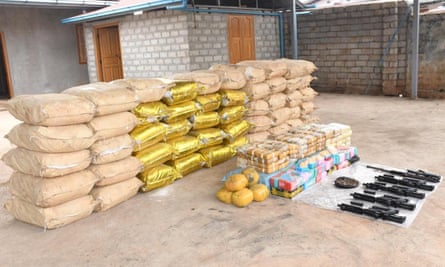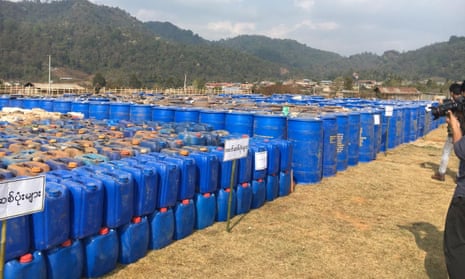Myanmar has made south-east Asia’s largest-ever seizure of synthetic drugs in raids that revealed “unprecedented” production of opioids in the area, the UN has said.
Between February and April, authorities swooped on labs in the lawless Kutkai area of Shan state, seizing nearly 200m meth tablets, 500kg (1,100lbs) of crystal meth, 300kg of heroin, and 3,750 litres of methyl fentanyl.
The United Nations Office on Drugs and Crime (UNODC) described the haul as one of the largest and most successful counter-narcotics operations in the history of the region.
“What has been unearthed through this operation is truly off the charts,” Jeremy Douglas, the UNODC south-east Asia and Pacific representative said in a statement.

The production network could have been possible only with the backing of serious transnational criminal groups, he added.
The raids unearthed “unprecedented” methyl fentanyl, the sign of a new trend of synthetic opioid production emerging “on a scale nobody anticipated”, said Douglas.
Fifty times stronger than heroin and up to 100 times more potent than morphine, fentanyl can be lethal from as little as two milligrams – the equivalent of a few grains of sand.
It has fuelled an opioid crisis in the US that killed 32,000 people in 2018.
Myanmar is under pressure to stem the deluge of drugs from its border regions. Shan state is part of the “Golden Triangle” – a wedge of land cutting into Myanmar, Laos, China and Thailand and virtually untroubled by authorities despite the multi-billion dollar trade.
Myanmar is the world’s second-biggest producer of heroin after Afghanistan, and is now widely thought to be the largest global source of meth, fuelled by the flood of precursor chemicals from China.

Cheap, caffeine-cut “yaba” pills – south-east Asia’s favourite high – are pushed regionally, prices tripling as they cross into Thailand and Malaysia.
The more addictive crystal meth, or “ice”, is smuggled to Tokyo, Seoul or Sydney, where it sells for around $150,000 a kilogram on the streets.
“Made-in-Myanmar” drugs are trafficked south through Thailand, north into China and west towards Bangladesh – a cascade of stimulants overwhelming regional policing efforts and seeding a crisis of addiction, corruption and money laundering.
Thirty-three people were arrested in the operations with authorities vowing to bring to justice criminal groups, traffickers and accomplices.
Colonel Zaw Lin from Myanmar’s anti-drugs police acknowledged the challenges ahead, but said the traffickers’ “days of operating ... are numbered”.
